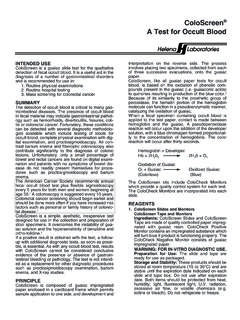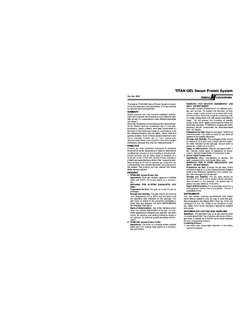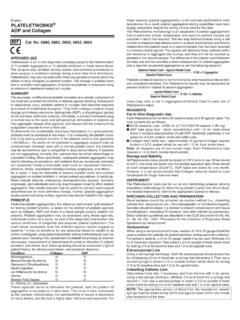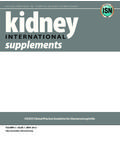Transcription of ELECTROPHORESIS PROCEDURE HELENA …
1 Beaumont, TexasHelenaLaboratoriesenvironmental factors of unknown mechanism such as diet, alcoholintake, and drugs, especially estrogen or steroid primary are those lipoproteinemias associated withketosis-resistant diabetes, pancreatitis, and obesity. Diabetes mellitusand pancreatitis can be confusing, for it is often difficult to tell whetherthe hyperlipoproteinemia or the disease is the causative LIPOPROTEINEMIAS:The Fredrickson ClassificationTYPE I: HyperchylomicronemiaCriteria: Chylomicrons present, pre-Beta normal or only slightlyelevated. Alpha and Beta decreased, often markedly so. Standingplasma with marked creamy : A measurement of post-heparin lipolytic activity (PHLA)and the demonstration of severe intolerance to exogenous fat. Thecondition is rare and always familial. There has been no correlation tovascular disease. It is thought to be due to a genetic deficiency oflipoprotein II: HyperbetalipoproteinemiaCriteria: Increased total cholesterol due to an increasedBeta-lipoprotein cholesterol.
2 Alpha cholesterol usually normal or IIa: normal pre-Beta, normal triglycerides, plasma IIb: increased pre-Beta and triglycerides, plasma clear toslightly turbid with no creamy is one of the most common familial forms of Causes: Myxedema, myelomas, macroglobulinemias,nephrosis, liver disease, excesses in dietary cholesterol and III: Broad Beta - Abnormal LipoproteinCriteria: Presence of triglyceride burdened lipoprotein of abnormalcomposition and density. Cholesterol and triglyceride elevated. Theabnormal material has broad beta electrophoretic mobility butseparates with VLDL in the ultracentrifuge. Plasma is turbid to abnormal lipoprotein is also known as floating Beta . Thecondition is : Polyacrylamide gel electrophoresis13or ultracentrifugestudies to demonstrate the abnormal IV: Carbohydrate Induced and EndogenousHypertriglyceridemiaCriteria: Increased pre-Beta, increased triglycerides, normal or slightlyincreased total cholesterol, Alpha and Beta lipoprotein usually normal.
3 (An increased pre-Beta with normal triglyceride level is seen with thenormal variant sinking pre-Beta . Such samples do not belong to TypeIV.)Secondary causes: Nephrotic syndrome, diabetes mellitus,pancreatitis, glycogen storage disease, and other acute metabolismchanges where mobilization of free fatty acids is triglycerides are very sensitive to alcohol intake,emotional stress, diet and changes in weight. Little effect is seen withexogenous triglyceride intake. Ninety percent of persons with familialType IV have an abnormal glucose tolerance. Probably the mostcommon type of hyperlipoproteinemia reflecting an imbalance insynthesis and clearance of endogenous V: Mixed Triglyceridemia (Carbohydrate and fat induced)Criteria: Increased exogenous and endogenous triglycerides,cholesterol increased, chylomicrons present, pre-Beta increased, Betanormal to slightly causes: Nephrosis, myxedema, diabetic acidosis,alcoholism, pancreatitis, glycogen storage disease and other acutemetabolic : Only Types II, III and IV has been correlated to vascular ALPHA LIPOPROTEINS IN DISEASEM arked increase in the Alpha lipoproteins are seen in obstructive liverdisease and cirrhosis.
4 Marked decreases are seen in parenchymalliver disease. Tangier s disease is a rare genetic disordercharacterized by the total absence of normal Alpha exhibit decreased levels of should be notedthat hyperestrogenemia (pregnancy and oral contraceptive use) maycause moderate elevations in the Alpha IN THE BETA LIPOPROTEINSA betalipoproteinemia is a primary inherited defect characterized bysevere deficiency of all lipoproteins of density less than (all butthe Alpha lipoproteins). It is accompanied by numerous clinicalsymptoms and life expectancy is limited. A few cases of familialhypobetalipoproteinemia have been reported. There is some evidencethat the mutation is different from that producing is an abnormal lipoprotein often seen in patients withobstructive liver disease. It consists of unesterified cholesterol,phospholipids and protein.
5 It migrates slower than LDL. Because of itsparticular lipid contents, it stains poorly or not at all with the usual lipidstains and so is not usually detected by standard lipoproteinelectrophoretic Fredrickson, and Lees, , A System for Phenotyping Hyperlipoproteinemias,Circulation, 31(3):321-327, Henry, Ed., Clinical Diagnosis and Management of Laboratory Methods, 17th Saunders Co., New York, 194-201, Lewis, and Opplt, Ed., CRC Handbook of ELECTROPHORESIS Vol II Lipoproteins inDisease, CRC Press, Inc., Florida, 63-239, Levy, and Fredrickson, , Diagnosis and Management of Hyperlipoproteinemia,Am. J. Card, 22(4):576-583, Houtsmuller, , Agarose-gel ELECTROPHORESIS of Lipoproteins: A Clinical ScreeningTest, Koninklijke Van Gorcum and Comp, The Nederlands, p. 5, Stonde, and Levy, , The Hyperlipidemias and Coronary Artery Disease,Disease-a-Month, Dahlen, G.
6 , The Pre-Beta Lipoprotein Phenomenon in Relation to Serum Cholesterol andTriglyceride Levels: The Lp(a) Lipoprotein and Coronary Heart Disease, Umea UniversityMedical Dissertations, Sweden, No. 20, Fredrickson, , Levy, , Lees, , Fat Transport in Lipoproteins - An IntegratedApproach to Mechanisms and Disorders, N Eng Jour Med, 276:34-42, 94-103, 148-156,215-226, 273-281, Fredrickson, , When to Worry about Hyperlipidemia, Consultant, Dec. Houtsmuller, , Heparin-Induced Post Beta Lipoproteins, Lancet 7470, II, 976, Hatch, and Lees, , Practical Methods for Plasma Lipoprotein Analysis, AdvanLipid Res 6:1, Davidsohn, I., and Henry, , Todd-Sanford: Clinical Diagnosis by Laboratory Methods,15th ed., p. 638-639, Masket, , Levy, and Fredrickson, , The Use of Polyacrylamide GelElectrophoresis in Differentiating Type III Hyperlipoproteinemia, J Lab & Clin Med, 81(5):794-802, World Health Organization Memorandum: Classification of Hyperlipidemias andHyperlipoproteinemias, Circulation, 45:501-508, 1972.
7 Item Hardware Cat. Z-12 Applicator 4090 Super Z-12 Sample Well Plate (2) 4096 Super Z/CPK Aligning Base 4094 Super Z Applicator 4084 Super Z Sample Well Plate (2) 4085 Super Z Aligning Base 4086 Zip Zone Applicator 4080 Zip Zone Sample Well Plate 4081 Zip Zone Aligning Base 4082 Zip Zone Chamber 1283 Microdispenser and Tubes 60081000 Staining Set 5122 Bufferizer 5093 Coolant Sponges 5045 Consumables Cat. III Lipo (94 mm x 76 mm) 3901 Titan III Lipo (76 mm x 60 mm) 3900 Electra HR Buffer 5805 Lipotrol 5069 Lipoprotein Stain 5322 Blotters (108 mm x 89 mm) 5037 Blotters (102 mm x 76 mm) 5034 Lipoprotein Report Forms (1 pad) 5214 Zip Prep 5090 Titan Plastic Envelopes (large) 5053 Titan Plastic Envelopes (small) 5052 HELENA Marker 5000 Identification Labels 5015 Zip Zone Chamber Wicks 5081 Glue Stick 5002 Lipoprotein Storage Bags (117 mm x 102 mm)5101 Lipoprotein Storage Bags (117 mm x 82 mm)
8 5100 Quality Control Chart 5109 For Sales, Technical and Order Information and Service Assistance, call 800-231-5663 toll free. HELENA Laboratories warrants its products to meet our published specifications and to be free from defects inmaterials and workmanship. HELENA s liability under this contract or otherwise shall be limited to replacement orrefund of any amount not to exceed the purchase price attributable to the goods as to which such claim is alternatives shall be buyer s exclusive remedies. In no case will HELENA Laboratories be liable for consequentialdamages even if HELENA has been advised as tothe possibility of such damages. The foregoing warranties are in lieu of all warranties expressed or implied including, but not limited to, the impliedwarranties of merchantability and fitness for a particular 35/95(7)The HELENA Lipoprotein ELECTROPHORESIS PROCEDURE is intended forseparation and quantitation of plasma lipoproteins by cellulose Fredrickson and Lees proposed a system for phenotypinghyperlipoproteinemia in 19651, the concept of coronary artery diseasedetection and prevention utilizing lipoprotein ELECTROPHORESIS hasbecome a studies have related dietary intake of fats, especiallycholesterol, and elevated blood levels of lipids with the incidence ofatherosclerosis, the major manifestations of which are cardiovasculardisease and stroke.
9 Ischemic heart disease has also been related , 3 The need for accurate determination of lipoprotein phenotypes resultedfrom the recognition that hyperlipoproteinemia is symptomatic of agroup of disorders dissimilar in clinical features, prognosis andresponsiveness to treatment. Since treatments of the disorders varywith the different phenotypes, it is absolutely necessary that the correctphenotype be established before therapy is In theclassification system proposed by Fredrickson and Lees, only types II,III and IV have a proven relationship to lipids do not circulate freely in the plasma, but are transportedbound to protein and can thus be classified as lipoproteins. Thevarious fractions are made of different combinations of protein,cholesterol, glycerides, cholesterol esters, phosphatides and free techniques have been employed to separate the plasmalipoproteins, including ultracentrifugation, thin layer chromatography,immunological techniques, and and ultracentrifugation are two of the most widely usedmethods and each has given rise to its own terminology.
10 Table I showsthe correlation of these classifications and the relative lipid and proteincomposition of each I: Classification and Composition of Lipoprotein Fractions Classification according to: Composition-% in each fraction Electrophoretic Ultra- Pro- Gly- Chol- Phospho- Mobility Centrifuge tein ceride esterol lipidsChylomicrons 2%98%Beta LDL* 21%12%45%22%pre-Beta VLDL* 10%55%13%22%Alpha HDL* 50%6%18%26%*Non standard abbreviations: LDL (low density lipoprotein), VLDL (verylow density lipoprotein), HDL (high density lipoprotein).Various exceptions to the above classifications inevitably exist. One ofthese is the sinking pre-beta , which is pre-beta migrating materialwhich sinks in the ultracentrifuge along with the LDL (beta migrating) This is the Lp(a) lipoprotein reported by It isconsidered a normal variant found in 10% of the exception is the floating beta , which is migrating material floating in the ultracentrifuge with the VLDL.








